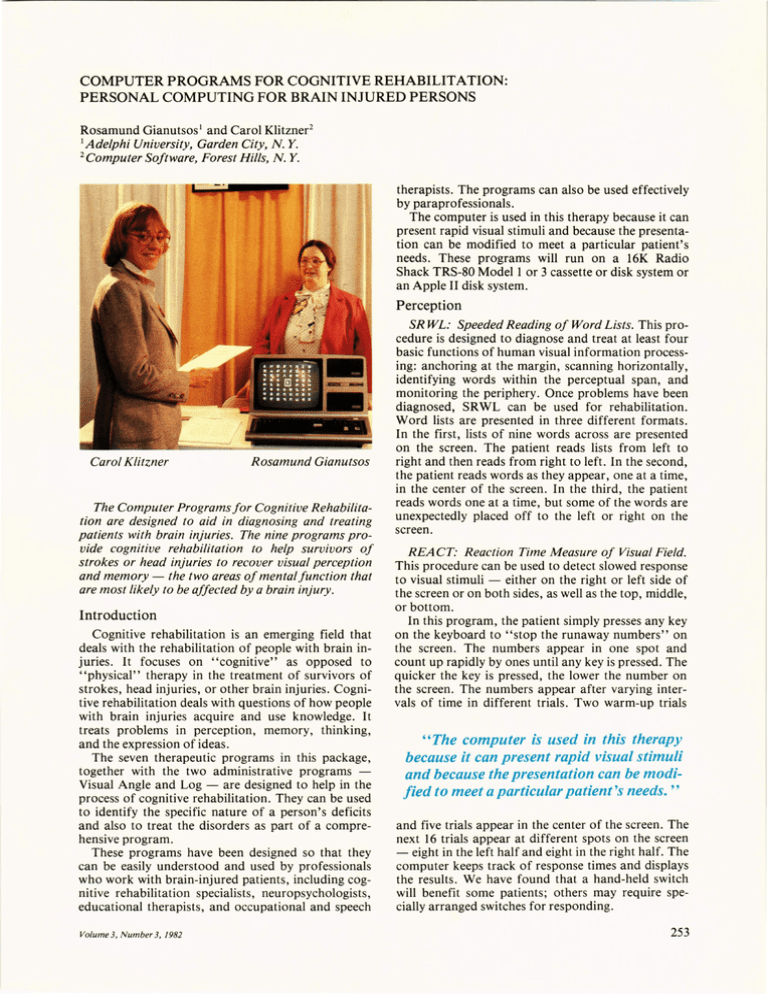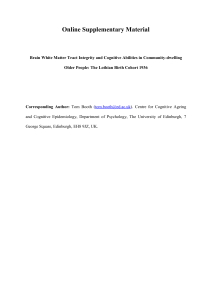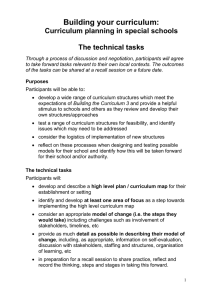COMPUTER PROGRAMS FOR COGNITIVE REHABILITATION: PERSONAL COMPUTING FOR BRAIN INJURED PERSONS
advertisement

COMPUTER PROGRAMS FOR COGNITIVE REHABILITATION: PERSONAL COMPUTING FOR BRAIN INJURED PERSONS Rosamund Gianutsos I and Carol Klitzner 2 I Adelphi University, Garden City, N. Y. 2 Computer Software, Forest Hills, N. Y. therapists. The programs can also be used effectively by paraprofessionals. The computer is used in this therapy because it can present rapid visual stimuli and because the presentation can be modified to meet a particular patient's needs. These programs will run on a 16K Radio Shack TRS-80 Model 1 or 3 cassette or disk system or an Apple II disk system. Perception Carol Klitzner Rosamund Gianutsos The Computer Programs for Cognitive Rehabilitation are designed to aid in diagnosing and treating patients with brain injuries. The nine programs provide cognitive rehabilitation to help survivors of strokes or head injuries to recover visual perception and memory - the two areas of mental function that are most likely to be affected by a brain injury. Introduction Cognitive rehabilitation is an emerging field that deals with the rehabilitation of people with brain injuries. It focuses on "cognitive" as opposed to "physical" therapy in the treatment of survivors of strokes, head injuries, or other brain injuries. Cognitive rehabilitation deals with questions of how people with brain injuries acquire and use knowledge. It treats problems in perception, memory, thinking, and the expression of ideas. The seven therapeutic programs in this package, together with the two administrative programs Visual Angle and Log - are designed to help in the process of cognitive rehabilitation. They can be used to identify the specific nature of a person's deficits and also to treat the disorders as part of a comprehensive program. These programs have been designed so that they can be easily understood and used by professionals who work with brain-injured patients, including cognitive rehabilitation specialists, neuropsychologists, educational therapists, and occupational and speech Volume 3, Number 3,1982 SR WL: Speeded Reading of Word Lists. This procedure is designed to diagnose and treat at least four basic functions of human visual information processing: anchoring at the margin, scanning horizontally, identifying words within the perceptual span, and monitoring the periphery. Once problems have been diagnosed, SRWL can be used for rehabilitation. Word lists are presented in three different formats. In the first, lists of nine words across are presented on the screen. The patient reads lists from left to right and then reads from right to left. In the second, the patient reads words as they appear, one at a time, in the center of the screen. In the third, the patient reads words one at a time, but some of the words are unexpectedly placed off to the left or right on the screen. REA CT: Reaction Time Measure of Visual Field. This procedure can be used to detect slowed response to visual stimuli - either on the right or left side of the screen or on both sides, as well as the top, middle, or bottom. In this program, the patient simply presses any key on the keyboard to "stop the runaway numbers" on the screen. The numbers appear in one spot and count up rapidly by ones until any key is pressed. The quicker the key is pressed, the lower the number on the screen. The numbers appear after varying intervals of time in different trials. Two warm-up trials "The computer is used in this therapy because it can present rapid visual stimuli and because the presentation can be modified to meet a particular patient's needs. " and five trials appear in the center of the screen. The next 16 trials appear at different spots on the screen - eight in the left half and eight in the right half. The computer keeps track of response times and displays the results. We have found that a hand-held switch will benefit some patients; others may require specially arranged switches for responding. 253 Two types of trials are possible. Either the patient may look anywhere on the screen using both eyes or the patient may cover one eye and look at a spot in the center of the screen, reacting to the numbers that appear there or in the peripheral areas. The second mode is an automated test of the central visual field. SEARCH: Searching for Shapes. This program is designed to detect and treat differences in attention and responsiveness on the two sides of the visual field. In the program, the patient is presented with an array of abstract shapes. The array is eight rows by eight columns; in the center spot there is a box. When a shape appears in the box, the patient searches for the matching shape elsewhere on the screen. When the match is located, the patient presses the space bar. The therapist then indicates whether the response is correct. The computer stores the search times for correct responses as well as the number of incorrect matches for later display at the conclusion of the test. Memory FREEREC: Free Recall. This is a classic memory task from experimental psychology that permits differential measurement of both short- and long-term retention. It can be used to diagnose problems and in exercises to improve retention and to measure improvements. Commonly used, monosyllabic nouns (from the 1944 Thorndike-Lorge list) are presented one at a time, after which the patient tries to recall all the words. Words may be recalled out of order - usually people report the final words on the list first. In each protocol, there are 12 lists of 12 words each to be remembered. When the lists are presented, they are followed by a short interval. On half the lists, the patient simply pauses and at a signal from the computer tries to recall the words out loud. On the other half, the patient reads additional words after the 12 words are presented but does not try to remember these additional words. This reading task is intended to displace transient or short-term storage, so that only words from long-term storage are available for recall. The interval between completion of the list and the command to RECALL is always of equal duration. SPAN: Memory Span. This program is designed to help restore short-term storage capacity. It also indicates the ability to concentrate on a task. Impairments in short-term storage, identified with free recall or triplet recall, should be helped by this exercise. A list of words appears on the screen, one word at a time. At the end of the list, the patient tries to recall a certain number of words at the end of the list, depending on the instructions given. On the first five trials, the patient recalls the last two words; then for every five trials after that, the patient is asked to recall one additional word, up to a maximum of seven 254 words. The length of each list is unpredictable. In all, 30 lists are presented in rounds of five lists each. TRIPREC: Triplet Recall. This program gives results that show both short- and long-term storage. As it is fairly easy compared to free recall, it can be used by people for whom free recall is too difficult. It can be used as well for practice to improve memory. The task evolved from a classic experimental psychology study by L. R. Peterson and M. J. Peterson. Three words are presented one at a time, followed by 0, 3, or 9 words to be read, but not recalled, after a constant time interval. SEQREC: Sequence Recall. This task is based on the sequence pictures test by Dr. N. Mackworth and Dr. J. Mackworth of the Santa Clara Valley Medical Center in California, who propose it as a test of frontal lobe function, especially that of planning. Because it does not require the patient to read words aloud, the program can be used diagnostically and for treatment with patients unable to process verbal material, including non-English speakers, aphasics, and others. It can be set to a wide range of difficulty, from very easy to very hard. In this program, the patient sees a series of lists of nonsense words, shapes, short words, or pictures presented on the screen one at a time. The lists are set for varying lengths, from one to ten items. After the list, the patient is shown a menu of items that may have appeared on the list. The patient is to point to the items in the order in which they were shown. The computer then numbers the items in the correct order so the patient and therapist can see whether the patient recalled the items and the order correctly. The computer keeps track of correct and incorrect trials and gives a score at the end. In the course of therapy, the sequence lengths may be gradually increased. Administrative Programs LOG: Patient Log. This program gives a continuous record of patient activity. It keeps track of the programs that the patient worked on at every session and the comments that may have been entered about that session. It is of particular value for patients who have a computer for home therapy. When they come in for periodic sessions, printed copies are made of their LOG files. With this information, suitable guidance can be provided. The program is available only in a disk version and is most effective when used with a printer to obtain permanent printed records. VISANGLE: Visual Angle. This program helps the patient develop an understanding of the real-life implications of visual field test results, particularly angular measurement. When the width and distance of the target are entered, the computer will indicate how large an angle the target will occupy in the visual field. Johns Hopkins APL Technical Digest




